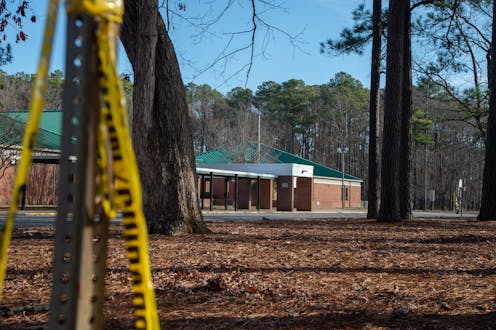
In the aftermath of a shocking incident in which a first grader shot and seriously injured a teacher at a school in Newport News, Virginia, the city’s mayor asked the question: “How did this happen?”
Some details are now known: The child took the gun from his home, and the firearm was legally purchased by his mother.
Many other aspects of the incident have yet to be established – not least, the likely many factors that resulted in the boy shooting his teacher. But as experts in media use and its connections to violence, we have reported some disturbing findings about how children are influenced by gun violence depicted in media like television, movies and video games. What makes this more troubling is the fact that millions of children in the U.S. have easy access to firearms in their homes, increasing the risk of gun deaths, including suicides.
The effect of media violence on children
Research has shown that the depiction of gun violence is increasing in both movies and on TV. Our research found that acts of gun violence in PG-13 movies has nearly tripled in the 30 years since the rating was introduced in 1984. And PG-13 movies are not exclusively watched by teens and above. A survey of adults in 2019 found that 12% said they were allowed to watch PG-13 movies between the ages of 6 and 9, with 6% saying they watched such films aged even younger.
Although some skeptics say violent media do not lead children to become more aggressive, a large survey conducted in 2015 found that most pediatricians and media scholars agree that there is a link.
Violent media can also lead children to engage in more dangerous behavior if they find a real gun. In studies one of us conducted, exposure to both movies and video games with guns was found to encourage children ages 8-12 years old to pick up a real gun that had been hidden in a drawer and pull the trigger, including while pointing the gun at themselves or their friend. This behavior was observed by a hidden camera.
This is what can happen if parents do not store a gun in a secure location in the home.
The child in the Virginia shooting was younger than 8 years old, but there is no reason to believe the effects we found would differ in a younger child. In fact, the effects might be stronger in younger children because those younger than about 8 can have more difficulty distinguishing reality from fantasy.
Violence in the media can desensitize or numb children to violence. In one study, researchers found that “children exposed to multiple sources of violence may become desensitized, increasing the possibility of them imitating the aggressive behaviors they watch and considering such behavior as normal.”
Movies containing gun violence that are rated PG-13 portray the use of guns in ways that are unrealistic. The effects of gun use in such films are often sanitized so that one rarely sees much blood or serious harm, unlike what is typically shown in movies that are rated R. This could give a child the sense that using a gun to harm someone is not as dangerous as it actually could be.
What concerns us about these findings is that they come at a time of increased media consumption by younger children. A 2021 report by Common Sense Media found that media use by children has risen faster in the two years since the pandemic than the four years before. Research has found that children ranging in age from 5 to 11 years old spent an average of more than three hours a day on screens and consuming media during the pandemic.
Guns in the home
Children are naturally curious, and adults often underestimate their ability to find guns hidden in the home. As one firearms expert noted, “Their brains are developing. That same curiosity that can inspire them to pick up a book and want to learn how to read can inspire them to go looking for a parent’s gun.”
And the U.S. has far more civilian-owned guns per capita than any country in the world, with 120.5 guns per 100 residents – the next highest country is Yemen, with 52.8 guns per 100 residents.
The U.S. is also an outlier when it comes to gun-related violence, with rates about 23 times higher than in other developed countries.
Figures from the nonprofit organization Everytown for Gun Safety show that every year more than 300 people are either wounded or killed in unintentional shootings by children. Data on the number of people shot by children intentionally is not, to our knowledge, available.
It is vital for gun owners to lock away firearms, unloaded, with ammunition stored separately – especially if there are children in the home. The American Academy of Pediatrics recommends that all guns be secured to decrease “the risk of both unintentional gun injuries and intentional shootings.” Roughly a third of U.S. homes with children have guns, but less than half of gun owners secure their guns. As of 2022, an estimated 4.6 million children in the U.S. live in a home with unlocked, loaded guns.
What drove the child at an elementary school in Virginia to shoot his teacher is something that is not publicly known. But what the research clearly shows is that exposure to gun violence in media and easy access to firearms around the home all serve to increase the risks of any child picking up a gun.
Dan Romer receives funding from the National Institutes of Health and from the Robert Wood Johnson Foundation.
Brad Bushman does not work for, consult, own shares in or receive funding from any company or organization that would benefit from this article, and has disclosed no relevant affiliations beyond their academic appointment.
This article was originally published on The Conversation. Read the original article.







